GMC YUKON XL 2002 Owner's Guide
Manufacturer: GMC, Model Year: 2002, Model line: YUKON XL, Model: GMC YUKON XL 2002Pages: 407, PDF Size: 3.25 MB
Page 31 of 407

1-24 CAUTION:A safety belt that is improperly routed, not
properly attached, or twisted won't provide the
protection needed in a crash. The person wearing
the belt could be seriously injured. After
installing the seat, always check to be sure that
the safety belts are properly routed and attached,
and are not twisted.
To replace the bench seat, do the following:
1. While holding the rear of the seat up, slide the front
wheels into the slots on the floor. The front latches
should lock into place. If the latches do not lock, try
tilting the rear of the seat upwards.
2. Once the latches are engaged, let the seat drop into
place. Release the lever labeled 1 to return the
seatback to its upright position.
3. Push and pull on the seat to make sure it is locked
into place. The seatback cannot be raised to the
upright position unless the seat is secured to the floor. Entering or Exiting the Third Row Seats
CAUTION: If the seatback isn't locked, it could move forward
in a sudden stop or crash. That could cause injury
to the person sitting there. Always press rearward
on the seatback to be sure it is locked.
Page 32 of 407

1-25Yukon Denali: To enter or exit the third row seat you
must fold the second row seat down following the
instructions given previously. If you are exiting the third
row seat with no assistance do the following:
1. Reach over the
second row seat
and pull up on the
strap loop. Then
pull the seat
cushion up.
2. Push the seat cushion forward.
3. Next, push the seatback forward until it is flat with
the floor.
Be sure to return the seat to the passenger position when
finished. Pull forward and push rearward on the seat to
make sure it is locked in place. Yukon XL Denali: The passenger's side of the
second row 60/40 or rear bucket seat has an easy
entry/exit feature. This makes it easy to get in and
out of the third row seat.
To operate the easy entry seat, do the following:
1. Turn the release
lever, located near
the back of the
seat, rearward.
2. Tilt the seatback toward the front of the vehicle and
the seat will release.
3. Pull (push if you are exiting the third row with no
assistance) the seat forward until it stops.
Be sure to return the seat to the passenger position when
finished. Pull forward and push rearward on the seat to
make sure it is locked in place.
Page 33 of 407
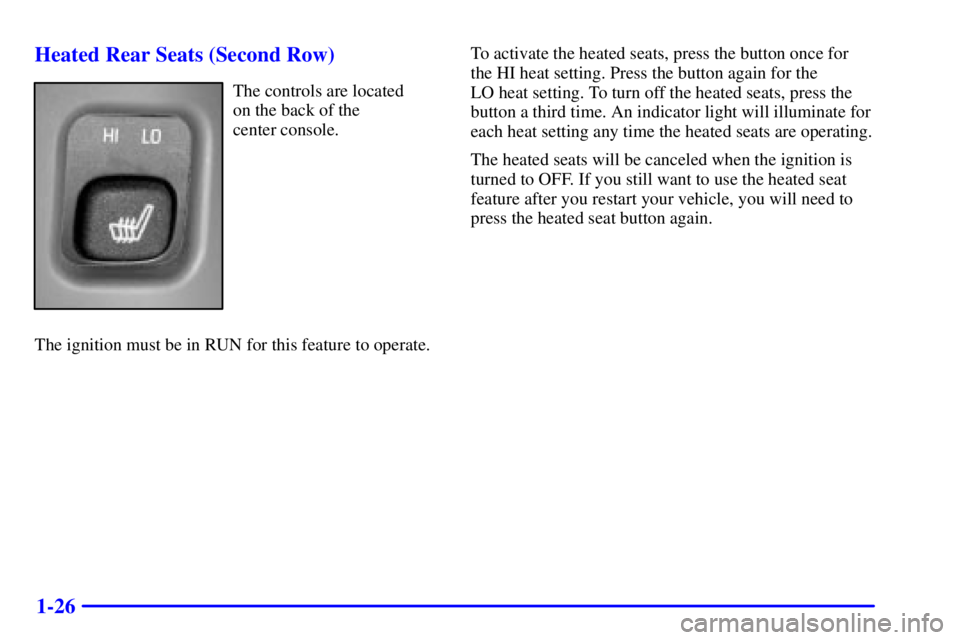
1-26Heated Rear Seats (Second Row) The controls are located
on the back of the
center console.
The ignition must be in RUN for this feature to operate. To activate the heated seats, press the button once for
the HI heat setting. Press the button again for the
LO heat setting. To turn off the heated seats, press the
button a third time. An indicator light will illuminate for
each heat setting any time the heated seats are operating.
The heated seats will be canceled when the ignition is
turned to OFF. If you still want to use the heated seat
feature after you restart your vehicle, you will need to
press the heated seat button again.
Page 34 of 407
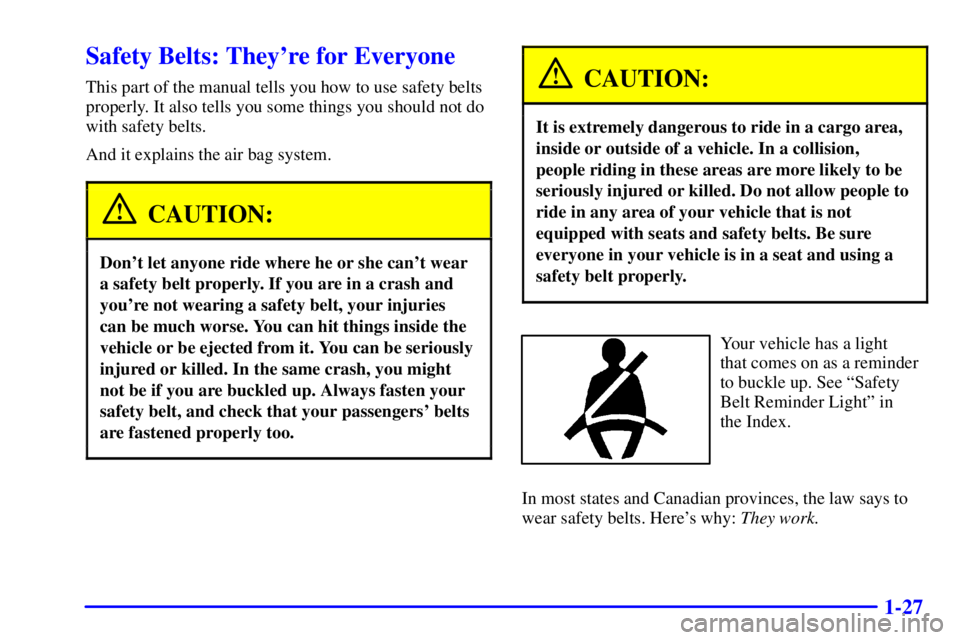
1-27Safety Belts: They're for Everyone This part of the manual tells you how to use safety belts
properly. It also tells you some things you should not do
with safety belts.
And it explains the air bag system.
CAUTION:Don't let anyone ride where he or she can't wear
a safety belt properly. If you are in a crash and
you're not wearing a safety belt, your injuries
can be much worse. You can hit things inside the
vehicle or be ejected from it. You can be seriously
injured or killed. In the same crash, you might
not be if you are buckled up. Always fasten your
safety belt, and check that your passengers' belts
are fastened properly too. CAUTION: It is extremely dangerous to ride in a cargo area,
inside or outside of a vehicle. In a collision,
people riding in these areas are more likely to be
seriously injured or killed. Do not allow people to
ride in any area of your vehicle that is not
equipped with seats and safety belts. Be sure
everyone in your vehicle is in a seat and using a
safety belt properly.
Your vehicle has a light
that comes on as a reminder
to buckle up. See ªSafety
Belt Reminder Lightº in
the Index.
In most states and Canadian provinces, the law says to
wear safety belts. Here's why: They work.
Page 35 of 407
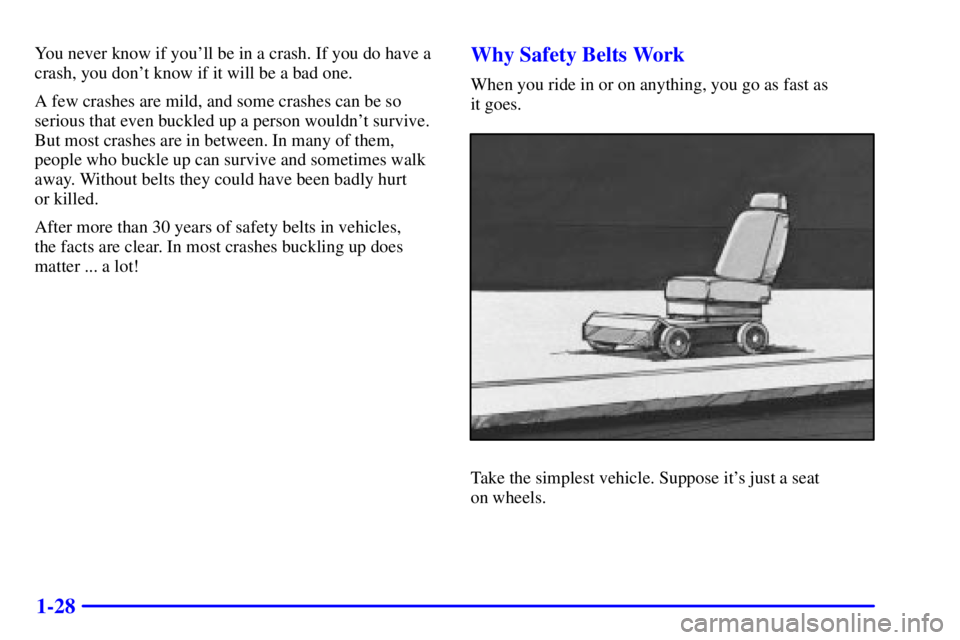
1-28 You never know if you'll be in a crash. If you do have a
crash, you don't know if it will be a bad one.
A few crashes are mild, and some crashes can be so
serious that even buckled up a person wouldn't survive.
But most crashes are in between. In many of them,
people who buckle up can survive and sometimes walk
away. Without belts they could have been badly hurt
or killed.
After more than 30 years of safety belts in vehicles,
the facts are clear. In most crashes buckling up does
matter ... a lot! Why Safety Belts Work When you ride in or on anything, you go as fast as
it goes.
Take the simplest vehicle. Suppose it's just a seat
on wheels.
Page 36 of 407
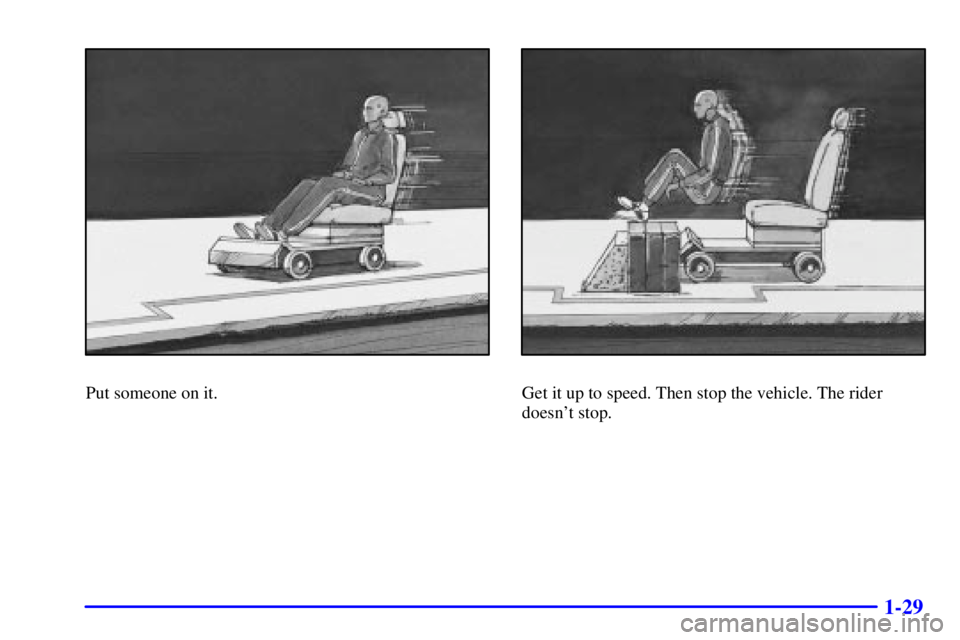
1-29Put someone on it. Get it up to speed. Then stop the vehicle. The rider
doesn't stop.
Page 37 of 407
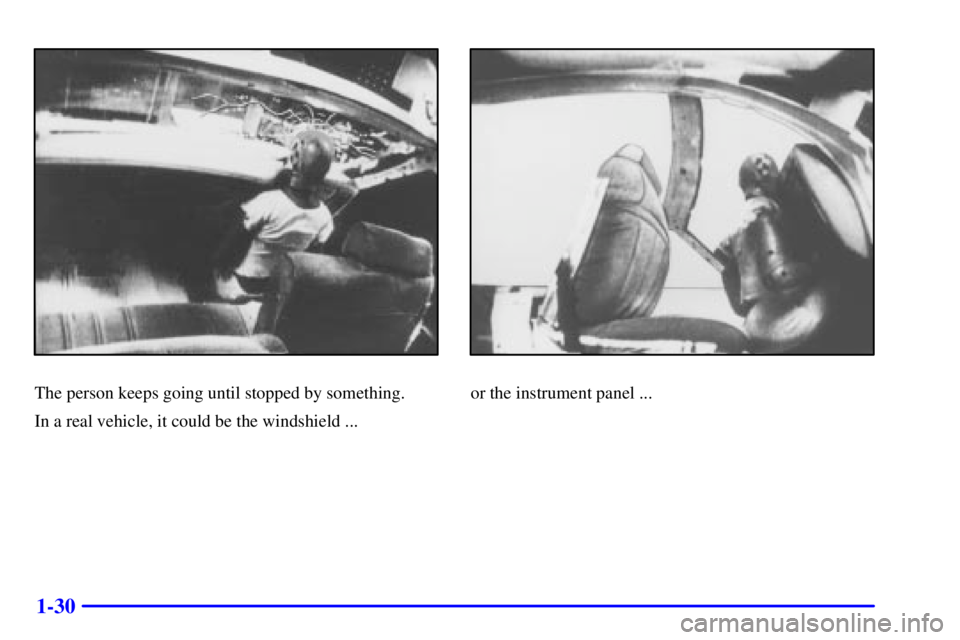
1-30 The person keeps going until stopped by something.
In a real vehicle, it could be the windshield ... or the instrument panel ...
Page 38 of 407

1-31or the safety belts!
With safety belts, you slow down as the vehicle does.
You get more time to stop. You stop over more distance,
and your strongest bones take the forces. That's why
safety belts make such good sense. Here Are Questions Many People Ask
About Safety Belts --
and the Answers
Q: Won't I be trapped in the vehicle after an
accident if I'm wearing a safety belt?
A: You could be
-- whether you're wearing a safety
belt or not. But you can unbuckle a safety belt,
even if you're upside down. And your chance of
being conscious during and after an accident, so
you can unbuckle and get out, is much greater if
you are belted.
Q: If my vehicle has air bags, why should I have
to wear safety belts?
A: Air bags are in many vehicles today and will be in
most of them in the future. But they are
supplemental systems only; so they work with
safety belts
-- not instead of them. Every air bag
system ever offered for sale has required the use of
safety belts. Even if you're in a vehicle that has air
bags, you still have to buckle up to get the most
protection. That's true not only in frontal collisions,
but especially in side and other collisions.
Page 39 of 407
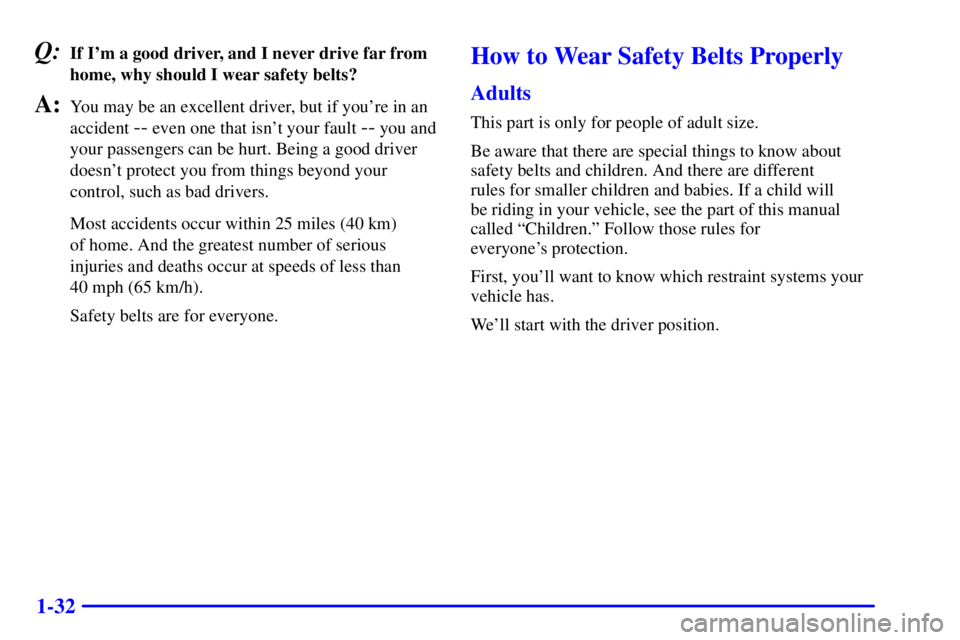
1-32Q: If I'm a good driver, and I never drive far from
home, why should I wear safety belts?
A: You may be an excellent driver, but if you're in an
accident
-- even one that isn't your fault
-- you and
your passengers can be hurt. Being a good driver
doesn't protect you from things beyond your
control, such as bad drivers.
Most accidents occur within 25 miles (40 km)
of home. And the greatest number of serious
injuries and deaths occur at speeds of less than
40 mph (65 km/h).
Safety belts are for everyone. How to Wear Safety Belts Properly Adults This part is only for people of adult size.
Be aware that there are special things to know about
safety belts and children. And there are different
rules for smaller children and babies. If a child will
be riding in your vehicle, see the part of this manual
called ªChildren.º Follow those rules for
everyone's protection.
First, you'll want to know which restraint systems your
vehicle has.
We'll start with the driver position.
Page 40 of 407

1-33Driver Position This part describes the driver's restraint system.
Lap-Shoulder Belt The driver has a lap
- shoulder belt. Here's how to wear
it properly.
1. Close and lock the door.
2. Adjust the seat so you can sit up straight. To see
how, see ªSeatsº in the Index.
3. Pick up the latch plate and pull the belt across you.
Don't let it get twisted.
4. Push the latch plate into the buckle until it clicks.
Pull up on the latch plate to make sure it is secure.
If the belt isn't long enough, see ªSafety Belt
Extenderº at the end of this section.
Make sure the release button on the buckle is
positioned so you would be able to unbuckle the
safety belt quickly if you ever had to.